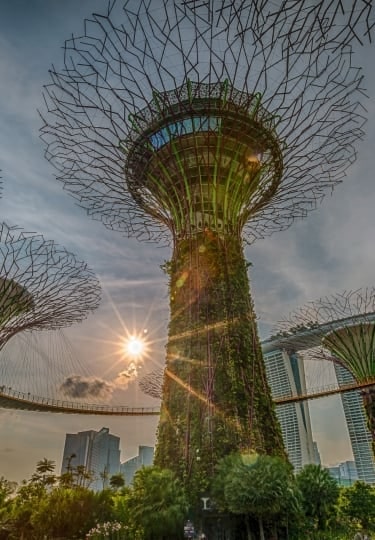What is Singapore known for? This state-city in Southeast Asia lies on the tip of the Malay Peninsula and is one of the best cities in the world for a culturally rich, tropical vacation.
Located close to the equator, Singapore is known for being warm year-round, with temperatures ranging from 82-93°F, creating a landscape of rich flora among the city’s soaring skyscrapers. This one-time British colony, which was also briefly part of Malaysia, is a melting pot of cultures and religions, with enticing neighborhoods including Little India, Chinatown, and Kampong Gelam among the city’s highlights.
Singapore is also known for its thrilling dining scene, with everything from hawker markets to Michelin-starred cuisine, plus a remarkable collection of museums, and fantastic shopping opportunities.
Singapore Sling
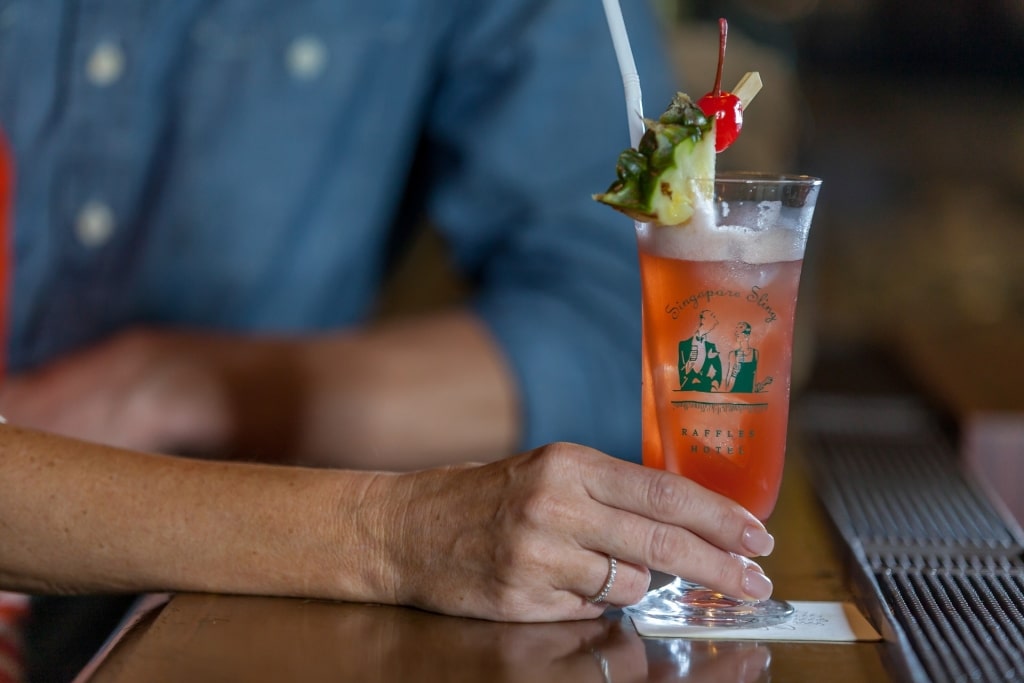
Singapore Sling
This fanciful fruity cocktail was invented at the iconic Long Bar at Singapore’s Raffles Hotel by bartender Ngiam Tong Boon in 1915.
The story goes that the Singapore Sling was created for women, who were prohibited from drinking alcohol at the time and were instead served teas and fruit juices. Ngiam Tong Boon came up with a creative way to serve an alcoholic drink, disgusting gin and liqueurs in what looked like a glass of fruit juice.
Though there are some variations of the recipe, most concoctions consist of gin, cherry brandy, Benedictine, bitters, pineapple, and lime juice. You’ll find it served in bars all over this modern city, from hole-in-the-wall hang-outs to upscale venues.

Long Bar
Bonus points if you secure a seat at the historic Long Bar to imbibe on refreshing glasses of Singapore’s unofficial national drink.
This two-story bar is one of the best in the world for its evocative 1920s feel, with rich earthy tones and the shells of peanuts typically discarded on the tiled floor. Visiting here is among the best things to do in Singapore for couples.
Hawker Centers
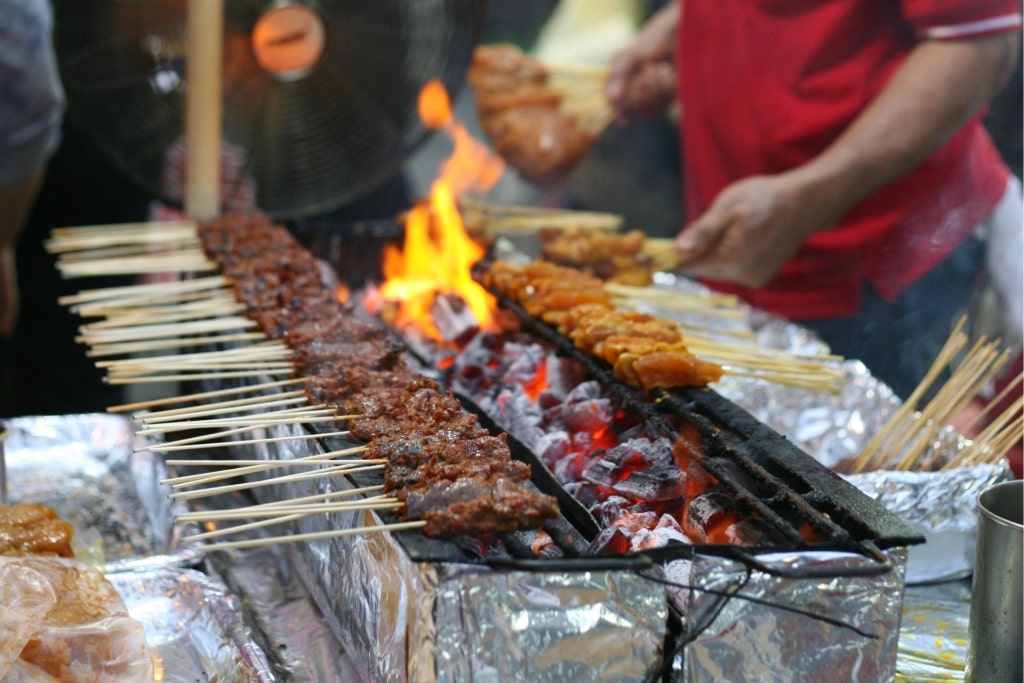
Lau Pa Sat
There are over 100 hawker centers in Singapore selling some of the tastiest dishes in the city. These intoxicating food courts are famous for serving inexpensive street food in a pared-back setting.
Popular Lau Pa Sat on Raffles Quay is set in a historic Victorian building serving wonton noodles, laksa noodle soup, chicken and rice, chicken and shrimp satay, pork dumplings, tea-soaked eggs, and nasi lemak among the myriad dishes.
Two stalls in the city—Hong Kong Soya Sauce Chicken Rice and Noodles at Chinatown Food Complex and Hill Street Tai Hwa Pork Noodles at Tai Hwa Eating House—have even held Michelin stars for their tasty cuisine.
Hawker centers have become such a cultural institution that they have been awarded UNESCO status, inscribed onto the List of the Intangible Cultural Heritage of Humanity in 2020.
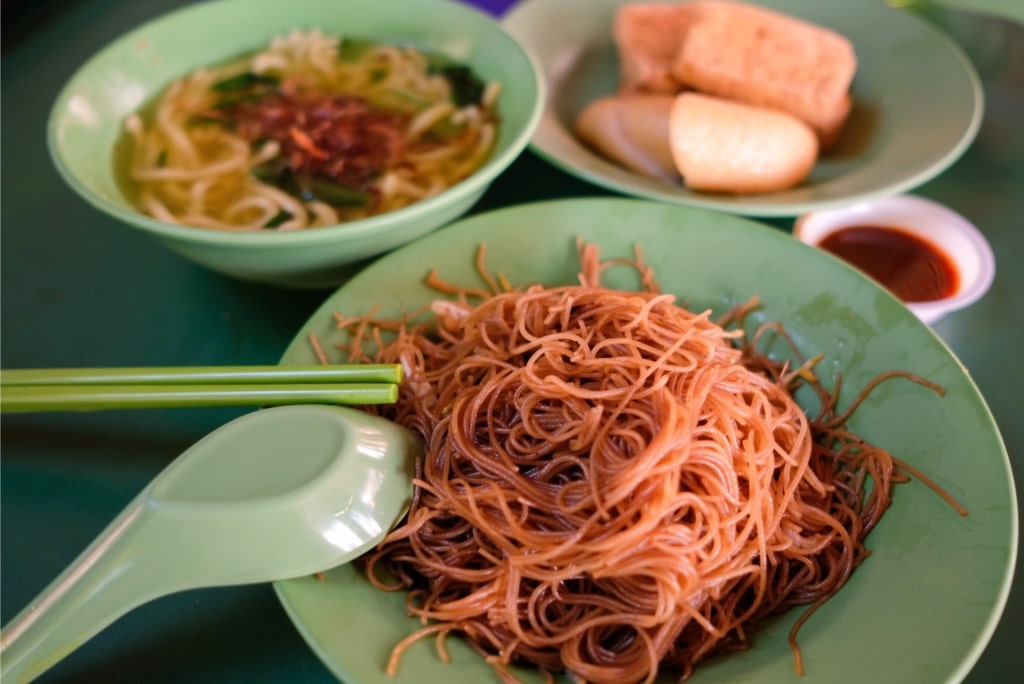
Maxwell Food Centre
Try a selection of Singaporean dishes, along with an ice-cold Tiger beer to cool off at spots such as Lau Pa Sat or Maxwell Food Centre in Chinatown. Just remember to clear away your food tray and any waste when you’ve finished—it’s an offense under the Environmental Public Health Act to leave it behind in spotless Singapore.
Architecture
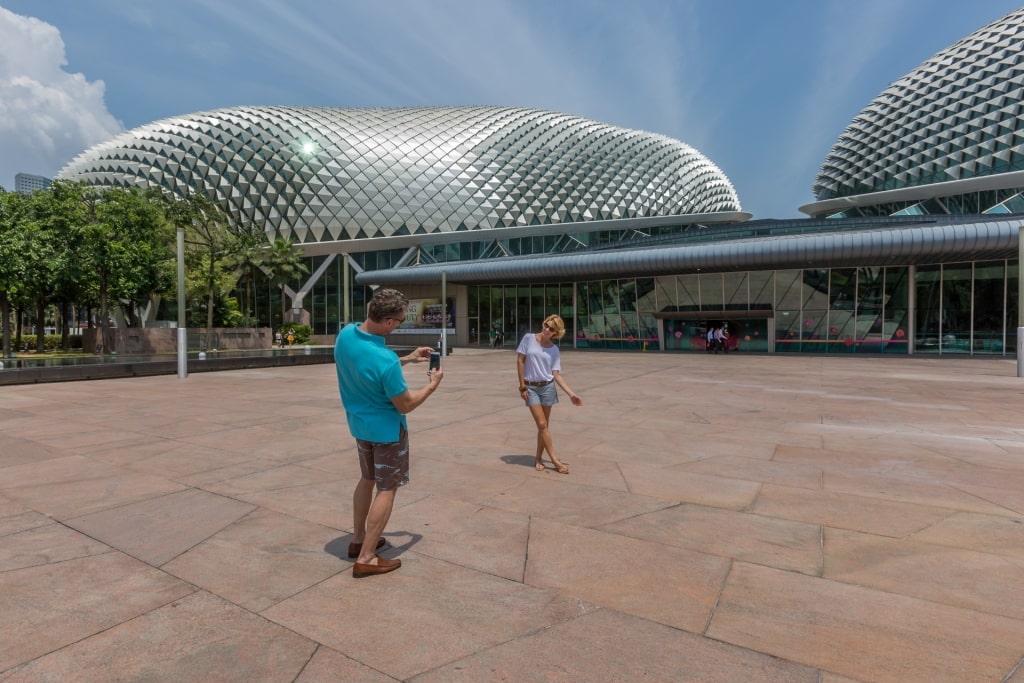
Esplanade
What is Singapore known for? From the twin-shells of the Esplanade art center to the lotus-flower design of the ArtScience Museum, architecture in Singapore is trailblazing and eclectic.
Elegant skyscrapers tower above traditional buildings, such as the pastel-hued Peranakan Houses in Katong-Joo Chiat and the 200-year-old Arts House theater, which was Singapore’s first parliament building.
Singapore’s religious architecture is outstanding—including Sri Mariamman, Singapore’s oldest Hindu temple in Chinatown, and the striking gold-domed Sultan Mosque in Kampong Gelam—and the solar-powered frames of the 18 colossal Supertrees at Gardens by The Bay are breathtaking.
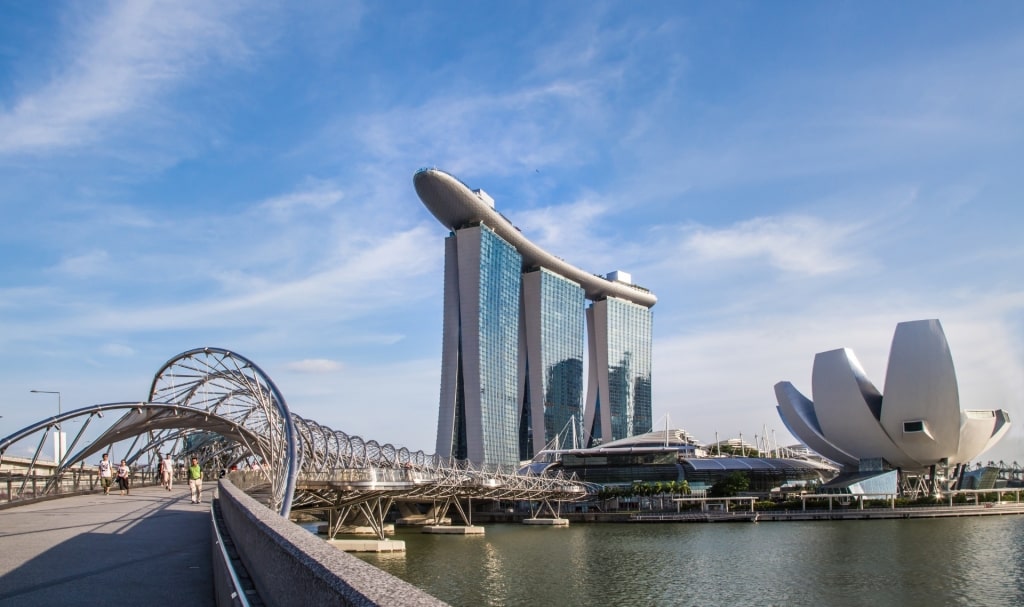
Marina Bay Sands
Among Singapore’s most famous buildings is the futuristic Marina Bay Sands. This unique building, designed by architect Moshe Safdie, consists of three towers linked by a glossy concourse at ground level and connected by a jaw-dropping rooftop observation deck on the 56th floor.
A hotel occupies the towers, with restaurants, bars, a casino, and boutiques filling the gleaming ground and rooftop. The showpiece is the rooftop infinity-edge pool flanked by palm trees. At 478-feet long, it’s the length of almost three Olympic swimming pools.
Visit the Sands SkyPark Observation Deck to witness Singapore’s skyline, and its joy-sparking architecture, from the best vantage point in town.
Little India

Little India
This lively enclave is one of Singapore’s most compelling neighborhoods, with tantalizing street food and flower garlands hung from pastel-hued storehouses.
Wander the streets around Little India’s two main thoroughfares, Race Course Road and Serangoon Road. Learn about Singapore’s Indian community through exhibitions and artifacts at the Indian Heritage Centre, next to the colorful Jothi Store & Flower Shop.
Marvel at the show-stopping Sri Veeramakaliamman. Dedicated to Kali, the goddess and destroyer of evil, this Hindu temple was built by Indian pioneers in the 19th century. The Little India Arcade is the place to go for henna body art and barter over gold, scarves, and handicrafts. There are saris, samosas, and spices, too.
On Tekka Lane, admire the beautiful two-story Tan Teng Niah House, the last surviving Chinese villa in Little India.
Helix Bridge
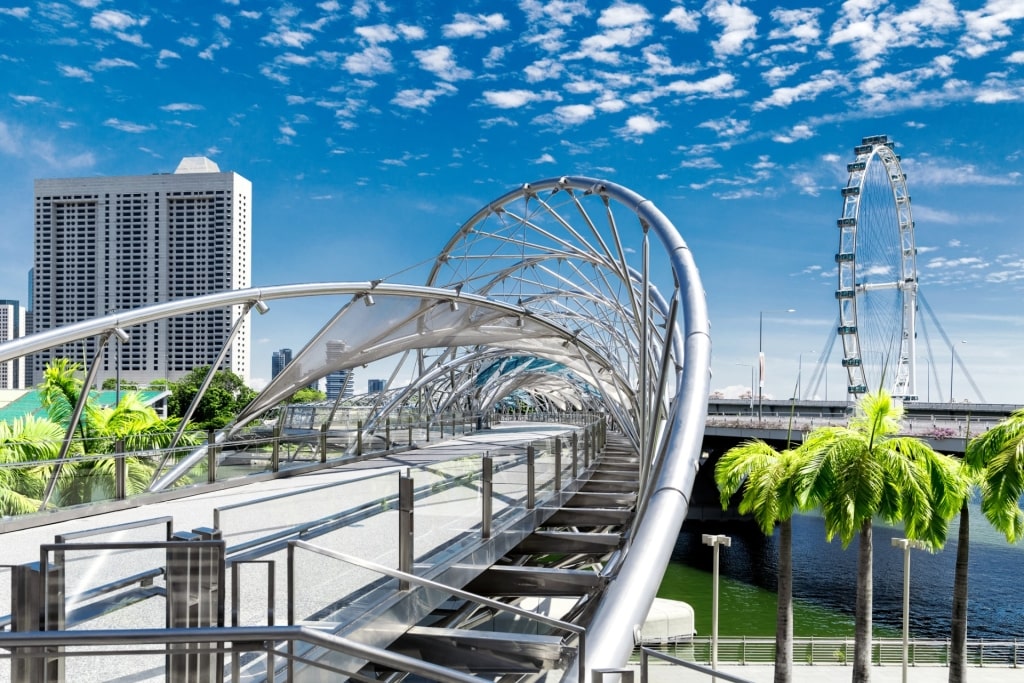
Helix Bridge
Spanning the Singapore River, Helix Bridge opened in 2010, linking Marina Centre with Marina South. This pedestrian bridge has gained iconic status for its unique design, inspired by the curving structure of human DNA.
There are four viewing platforms on this eye-catching bridge that offer sensational vistas of Singapore’s skyline, including the ArtScience Museum, Marina Bay Sands, and the Singapore Flyer, the city’s towering observation wheel.
Read: Best Skylines in the World
Kampong Gelam
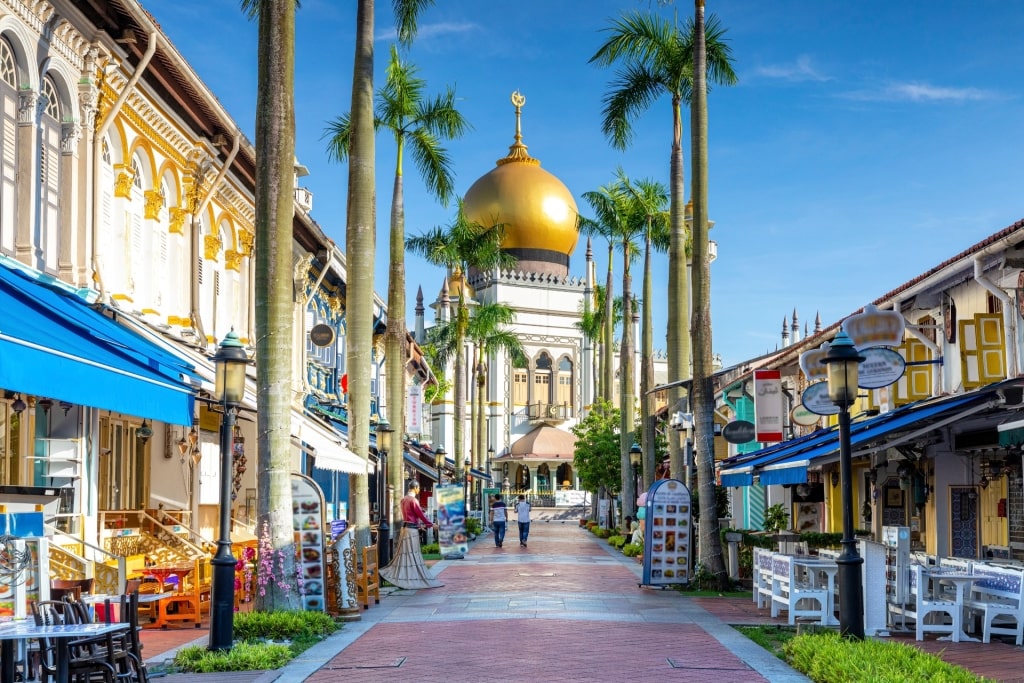
Kampong Gelam
Kampong Gelam is a vibrant Singapore neighborhood—historically the city’s Malay-Muslim quarter—next to Little India. It’s best known for its kaleidoscopic shuttered houses, often emblazoned with dazzling street murals, and occupied by ornate shophouses.
Marvel at the Sultan Mosque, with its gold domes shimmering above the neighborhood. The mosque was built in 1824 for Sultan Hussein Shah, the first sultan of Singapore, and is the largest mosque in Singapore.
What is Singapore known for? Shopping on Kampong Gelam’s Haji Lane, Arab Street, and Bussorah Street. An array of independent boutiques, coffee houses, and pizza joints line these narrow lanes. Don’t miss the back alleys, either, where you’ll find hidden galleries, cafes, and bars.
The charming shops of Kampong Gelam are among the city’s trendiest, offering gorgeous gifts and homewares such as dinnerware, antiques, candles, perfume, jewelry, and other souvenirs in Singapore.
Sentosa Island
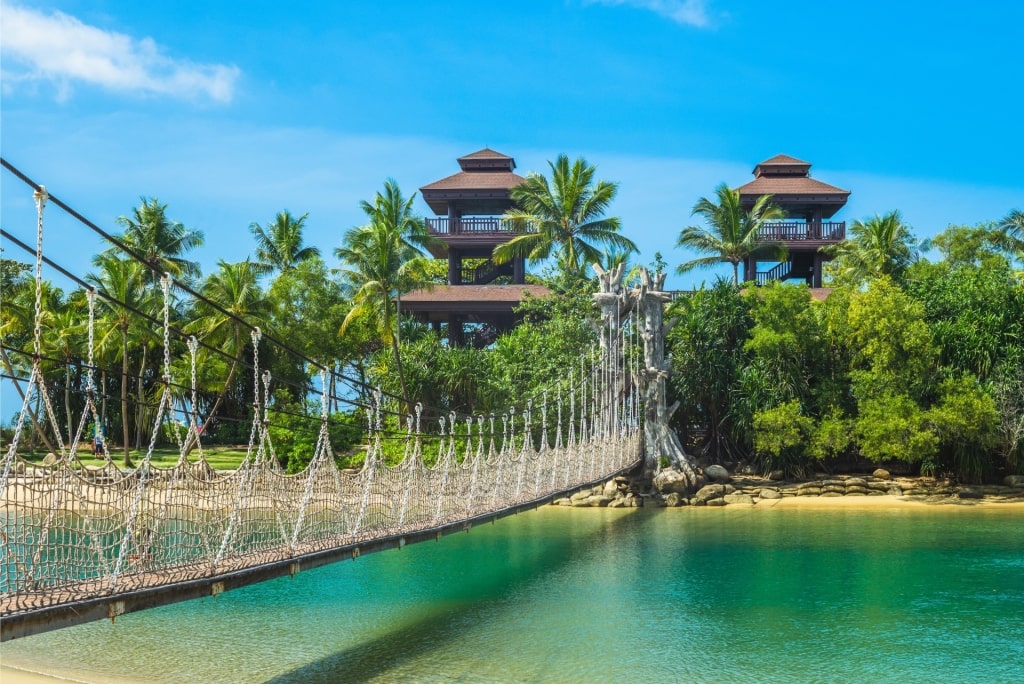
Sentosa Island
Off the south coast of Singapore, Sentosa is a 1,236-acre island resort that’s connected to the city by the pedestrian Sentosa Boardwalk, the Sentosa Gateway road, a cable car, and a monorail.
Sentosa offers a wonderful Singaporean beach escape, with the palm-fringed Palawan and Tanjong shores on the south coast home to golden sand and bath-warm water. There are beach bars and food stalls for chilled cocktails and satay by the sea.
Sentosa’s jungly backdrop is also home to Universal Studios Singapore, S.E.A. Aquarium, and Mega Adventure Park, making a visit one of the best things to do in Singapore with kids.
After lounging on the beach, swimming in the sea, and sipping tropical cocktails, wander across the pedestrian footbridge from Palawan Beach to the tiny Palawan islet. Here, you’ll find yourself among tilting palms, standing on the southernmost point of continental Asia.
Orchard Road

Orchard Road
Orchard Road is Singapore’s thronging main shopping boulevard, a 1.4-mile, tree-lined strip packed with shopping malls, luxury retailers, and places to eat and drink.
Pop into TANGS, Singapore’s first department store and the city’s answer to Bloomingdale’s with a world-beating food hall. Browse Design Orchard for its fabulous collection of Singapore-made wares. ION Orchard is a smart department store with a glamorous 56th-level observation bar, while Paragon and Ngee Ann City lures lovers of designer brands.
Once you’ve shopped the boutiques and malls of Orchard Road, veer onto Emerald Hill, a former nutmeg orchard off the main strip, with a row of pretty Peranakan shophouses. Stop at the delightful No.5 Emerald Hill to try their fiery signature drink, the Chilli Vodka.
Read: Three Days in Singapore
The Merlion
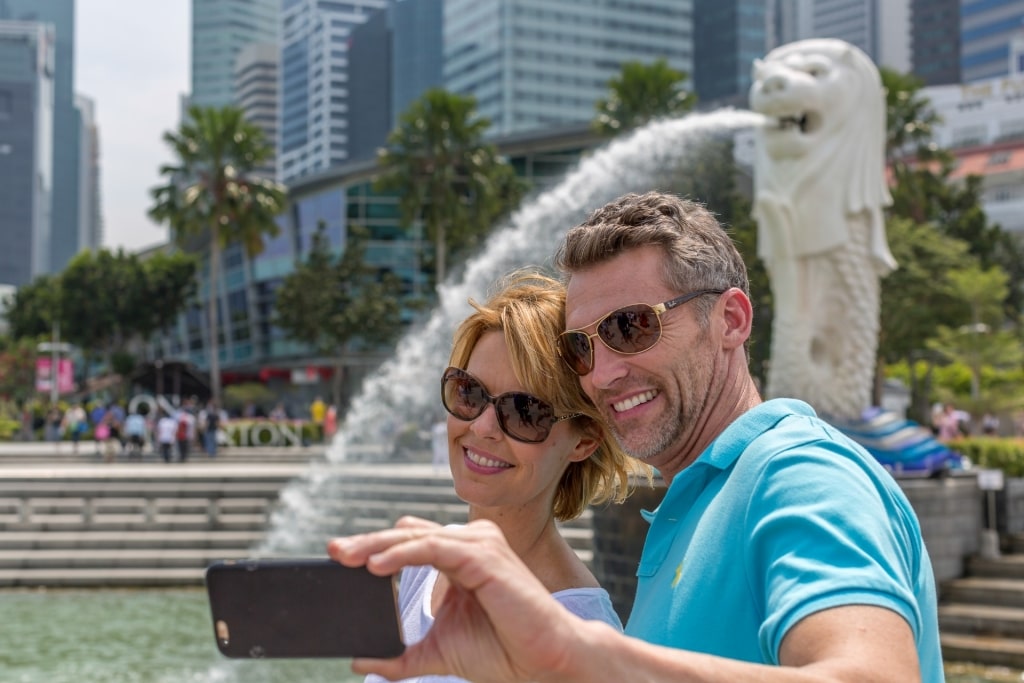
The Merlion
Perched on the tip of Merlion Park in front of the Fullerton Hotel, this 28-foot statue has the body of a fish and the head of a lion, shooting water from its mouth into Marina Bay at the mouth of the Singapore River.
As the city’s mascot, you’ll see the Merlion printed on signs and posters across Singapore. This mythical statue represents the island’s roots as a fishing village, once called Temasek, meaning “sea town,” and Singapore’s first-ever name, Singapura, which means “lion city” in Javanese.
Cross Jubilee Bridge from the Esplanade to visit Merlion Park and admire the statue before continuing along the snaking Singapore River.
See if you can locate the other Merlion statues in Singapore, too. There are six in total. One is located behind the main statue in Merlion Park, referred to as the Merlion cub; there’s one at Tourism Court near Orchard Road; there’s another at Faber Point on Mt. Faber; and two on Ang Mo Kio Avenue 1.
Green Spaces
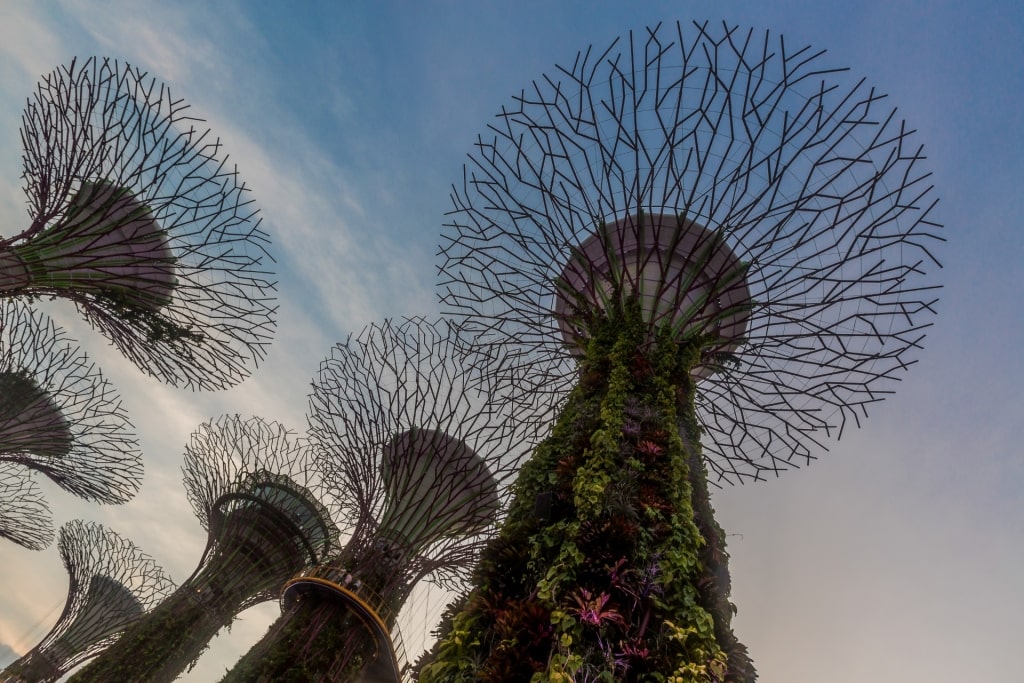
Supertrees Grove, Gardens by the Bay
With this dense metropolis filled with lush green spaces, including leafy parks and vertical gardens, Singapore is deserving of its Garden City name.
If you were to visualize Singapore, you will most likely see the 260-acre Gardens by the Bay and its 164-foot Supertrees Grove, soaring vertical gardens that light up in a dazzling evening display.
The breathtaking Gardens by the Bay is packed with flora and fauna, including the Flower Dome, inside Bay South Gardens, one of three waterfront gardens. The Flower Dome is the world’s largest glass greenhouse, containing flowers and plants from around the world including palm trees, orchids, magnolias, and ancient olive trees.

Cloud Forest, Gardens by the Bay
Stroll among Gardens by the Bay’s two-acre Cloud Forest, which replicates conditions found on tropical mountains in Southeast Asia and South America. Paths wind through the thick vegetation and behind a 115-foot waterfall, with ferns, many species of orchid, pitcher plants, and venus flytraps.
The UNESCO-listed Singapore Botanic Gardens is another tropical green space in this beautiful city. Located near Orchard Road, it’s home to the National Orchid Garden, consisting of around 1,200 of the 10,000 flower species at the Botanic Gardens and is the world’s largest collection of orchids. There’s also the Healing Garden, the Rainforest Trail, the Sundial Garden, as well as several lakes, fountains, and monuments to admire.
Another emerald-hued Singaporean landmark is the ParkRoyal Pickering, a hotel on Raffles Boulevard boasting an extraordinary 12-story vertical green garden.
Museums
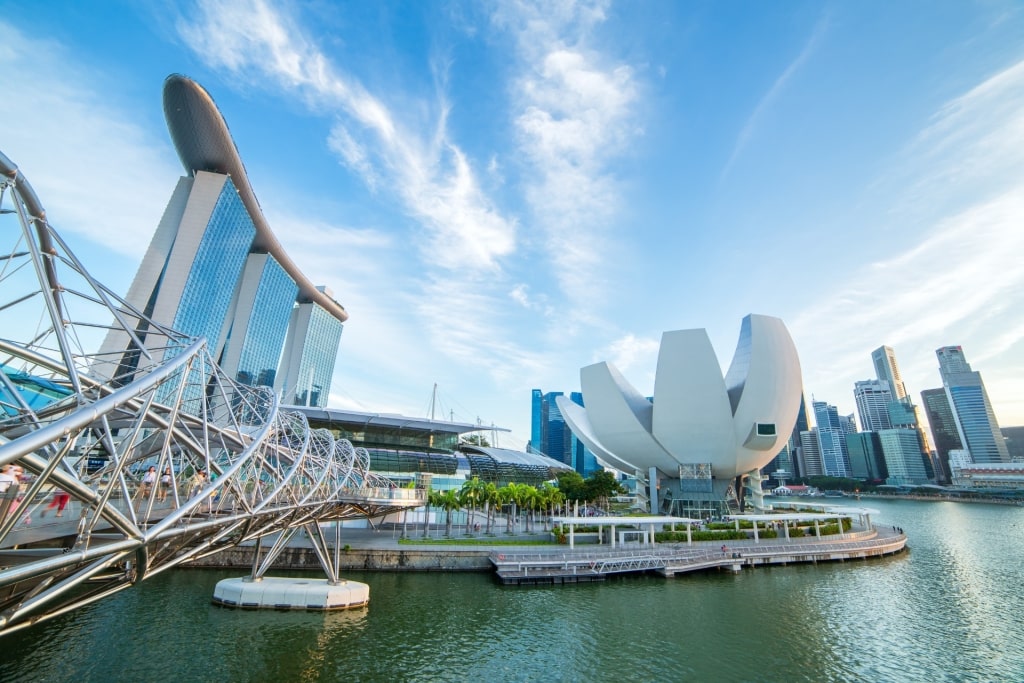
ArtScience Museum
Singapore is one of the best cities for art, and culture-thirsty travelers come to the city for its dozens of thrilling museums. Among the big hitters is the Singapore National Museum, where you can explore the city’s fascinating backstory and marvel at Singaporean art. This is Singapore’s oldest museum, having begun life in 1849 as the Raffles Library and Museum.
Delve into the glorious ArtScience Museum at Marina Bay Sands, which explores the intersection between art, science, culture, and technology. There are exhibitions on everything from the world’s greatest artists, including Leonardo da Vinci, Vincent Van Gogh, and Frida Kahlo, to quantum physics and paleontology.
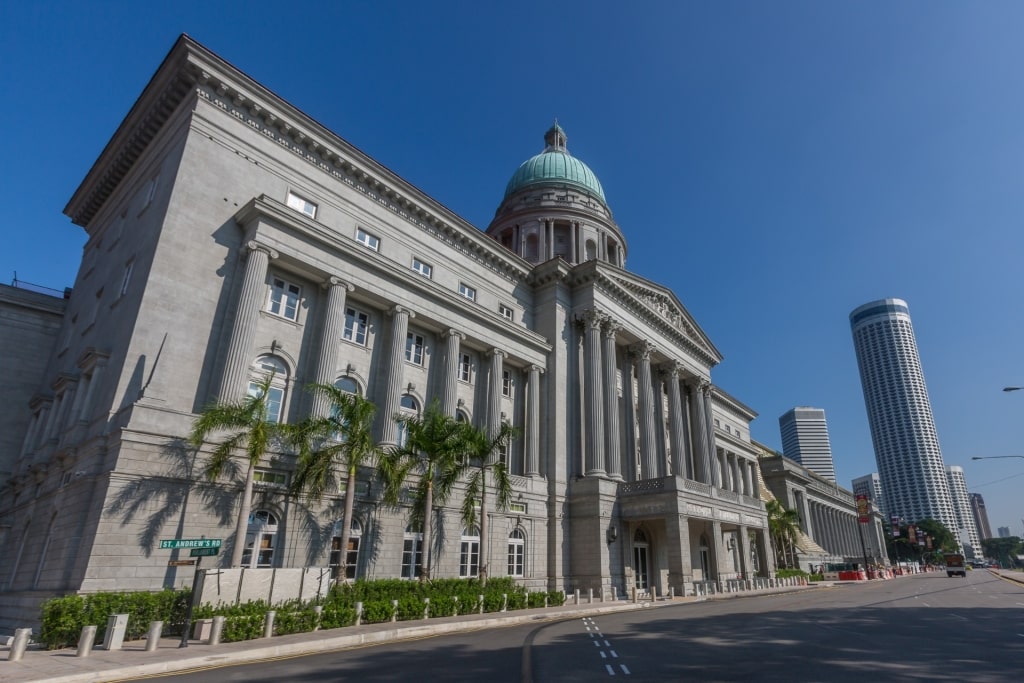
Singapore National Gallery
At Singapore National Gallery, discover the world’s largest collection of Singaporean and regional Southeast Asia art at the elegant former Supreme Court and City Hall buildings. Make a reservation for a lavish fine-dining lunch at the National Gallery’s French restaurant, Odette, to follow.
Study Singaporean cultures at the Peranakan Museum, Eurasian Heritage Gallery, and Malay Centre. Or try some of the city’s wonderfully offbeat museums, such as the Ant Museum and Music Box Museum.
Chinatown
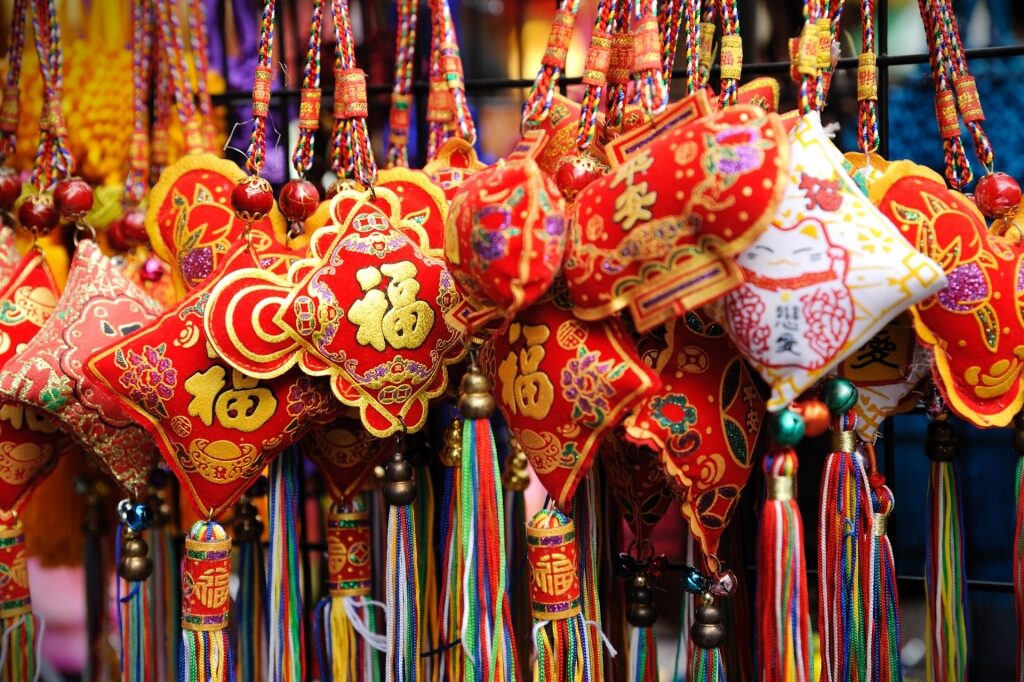
Chinatown
What is Singapore known for? Singapore’s Chinatown is one of the best—and most famous—in the world.
Festoon lighting and garlands of Chinese lanterns are draped across Chinatown’s warren of streets, with elders playing draughts below neon-lit signs and durian and dragon fruit piled high outside grocery stores.
This central district is best explored on foot, including Mosque Street, Temple Street, Pagoda Street, and Smith Street, with teahouses, herbal medicine stores, and crafts shops lining the strips. Browse the modern galleries, immaculate concept stores, and captivating street murals, among the many souvenir shops and Chinese restaurants.
Stop by the incense-scented Buddha Tooth Relic and Sri Mariamman temples, before sampling claypot rice—tender chunks of chicken, flavorsome vegetables, and rice served in a claypot—at the Chinatown Complex Food Centre.
Read: Singapore Vs. Hong Kong: Which Should You Visit?
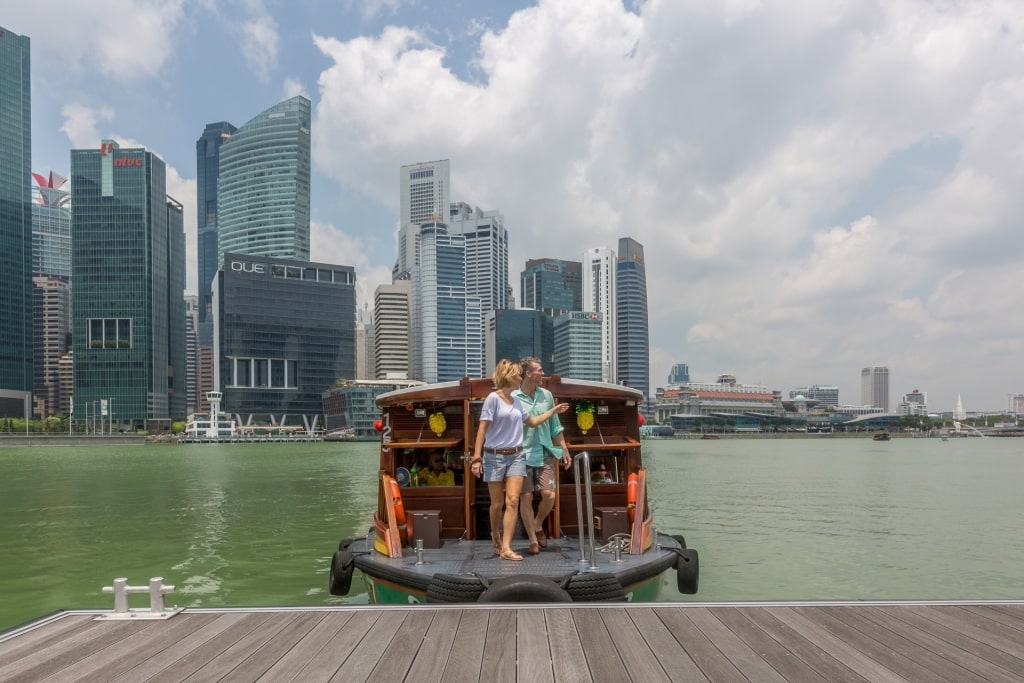
Bumboat cruise
Discover the melting pot of the Lion City for yourself on one of Celebrity’s cruises to Singapore.
